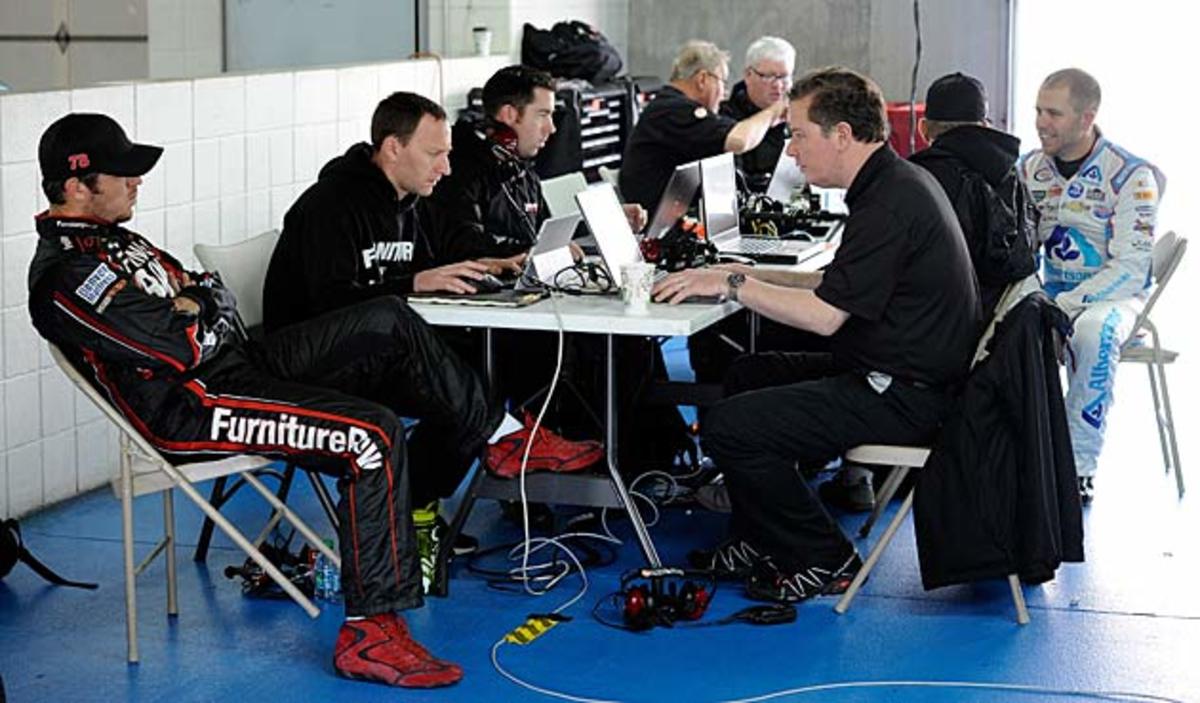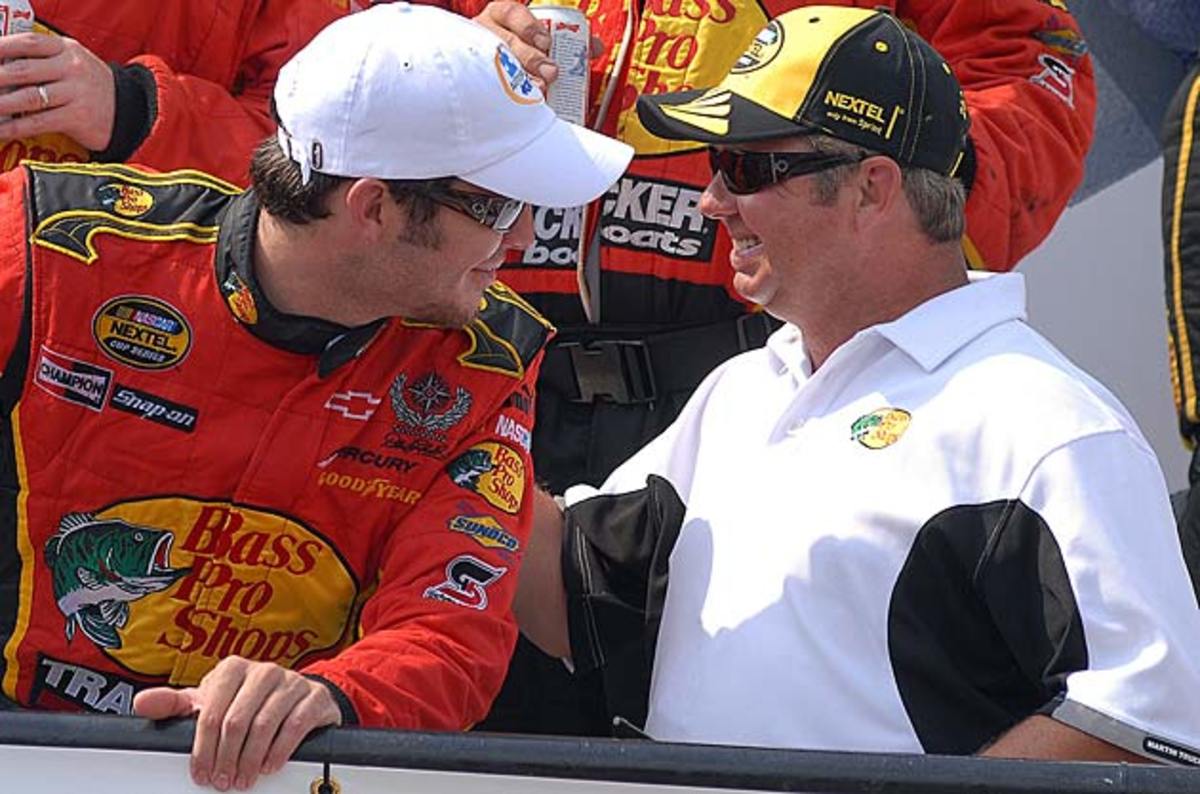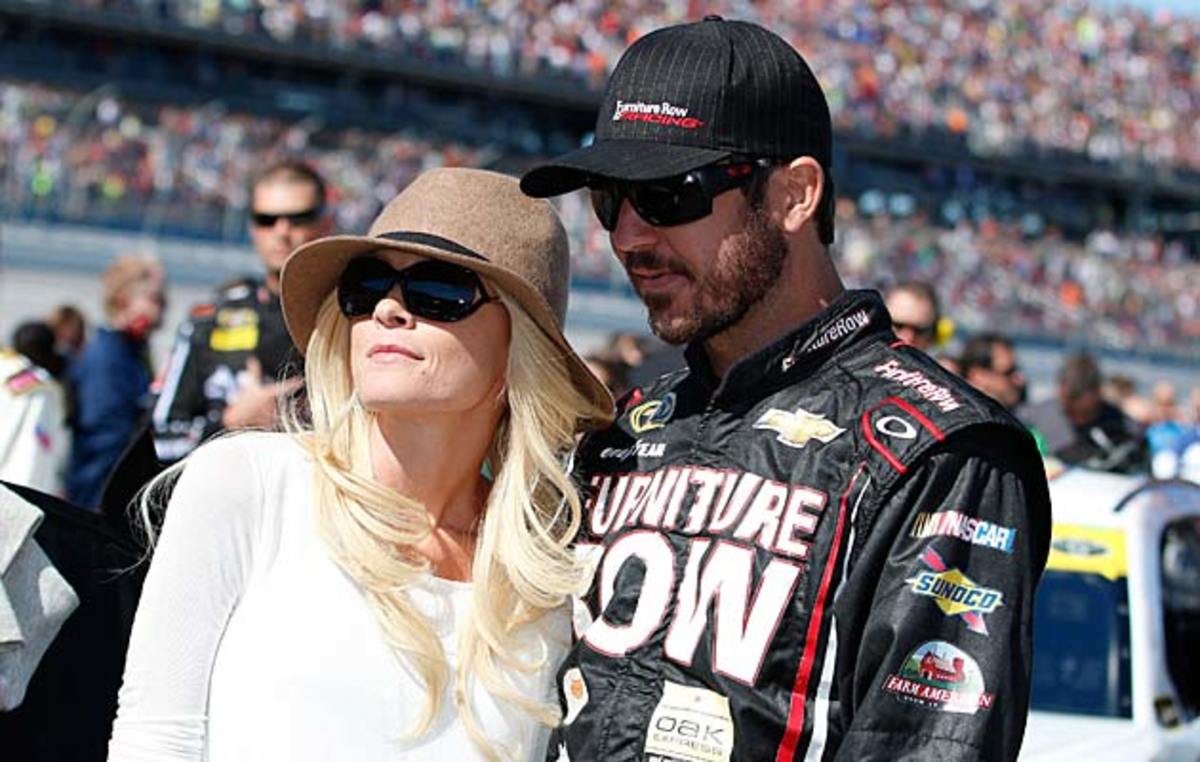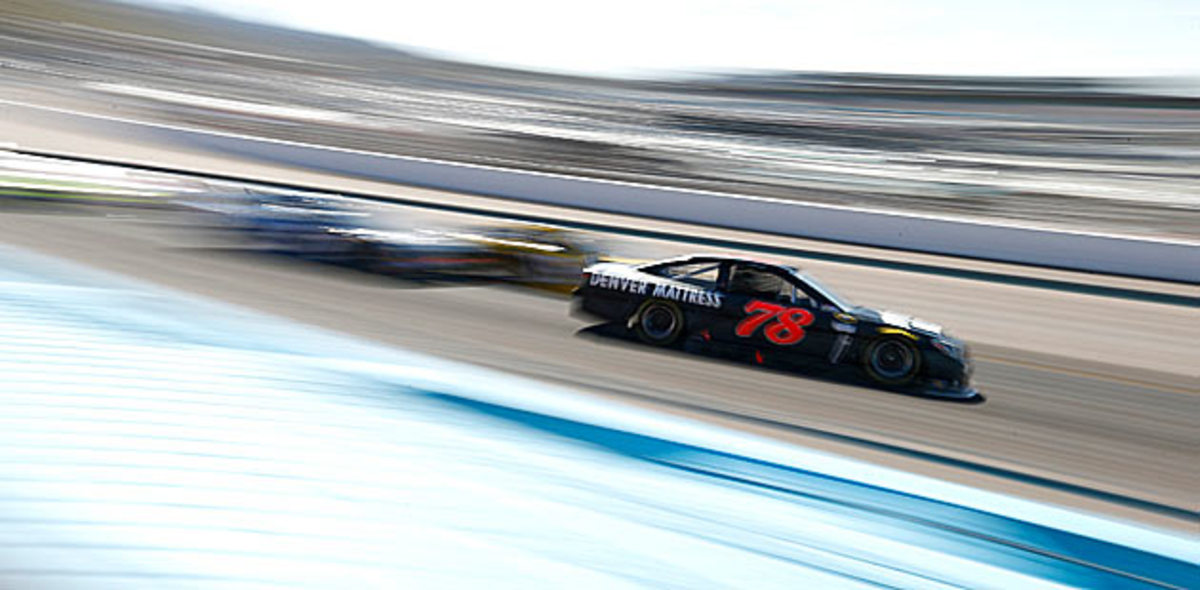Martin Truex Jr. leading NASCAR's single car brand of March Madness

Technically, Martin Truex Jr. has yet to register a victory in NASCAR’s young season. But that’s only because the official record doesn’t give the Sprint Cup pilot credit for winning the rat race. Traffic jams, long lines at Starbucks, cramped elevator rides—these are not obstacles he encounters on his daily commute. Nor is there a desk waiting for him somewhere at the end of that fraught journey for him to shackle himself all day.
No, Truex need only pick up his smartphone to attend meetings, exchange ideas and otherwise underscore his value to his peers. The setup, par for the Internet age, is still a bit odd for this sport, even after accounting for the 36 weekends each year that Truex spends bunkered with his officemates in speedway infields across the country. What’s more, it’s not as if the 34-year-old Truex becomes a chin-bearded racing recluse upon repairing home to the Charlotte area, where NASCAR itself is headquartered and an overwhelming number of racing teams reside. If anyone’s the stickler here, it’s his employer, Furniture Row Racing. It’s based in Denver, far from NASCAR country. The nearest racetrack is an eight-hour drive away in Kansas City.
This long-distance relationship would seem to be as doomed as any. Yet after almost two years, Truex and Furniture Row are stronger than ever. Truex has placed no lower than eighth in this season’s first four races and is ranked third in overall points. That he’s managed to do all this despite the 1,350 miles between him and his co-conspirators isn’t the only story here. Along with being one of NASCAR’s most remote teams, Furniture Row is also one of its smallest. But it’s Truex who has emerged as NASCAR’s employee of the month, so soon after surviving a 2014 season that wore him down personally and professionally.
The feelings of despair that once coursed through Truex and spiked when he found out that his longtime girlfriend, Sherry Pollex, had been diagnosed with ovarian cancer are nowhere in evidence as he heads into this weekend’s Sprint Cup race, the Auto Club 400 at Fontana, Calif. (Sun. 3:30 p.m. EST, Fox). Though he has been a solid performer on the moderately banked two-mile oval, where his average finish is 20.1 through 14 Cup starts, Truex is suddenly drawing quartloads of encouragement from a productive tire test there last fall. “We ran 2015 rules and learned a lot there that has helped us throughout this season,” says Truex, who is more confident than ever in his odds of punctuating NASCAR’s winter West Coast swing with an elusive trip to Victory Lane—a place he hasn’t officially toured since winning a 2013 summer road course race in Sonoma. “Honestly, we can run well everywhere.”
So can a handful of other single-car teams. It’s the damnedest thing, really.
• Five things to consider for Fontana
Market forces

Back in the day, before four-car super teams dominated the grid, Cup owners raced within their means. Generally, one car was the most they could afford to run. Then in the late-1970s, NASCAR came into some serious money—the bulk of it from Fortune 500 companies eager to hawk everything from lug nuts to laundry detergent. Of course with more money came more problems. The biggest was the fact that the drivers who were scaring up most of this sponsorship support didn’t like their meager cut of the profits. So rather than unionize, stars like Ricky Rudd, Bill Elliott and Darrell Waltrip decided to cut out the middle man entirely and, in the ’90s, began fielding their own teams. There, they set aside rides for themselves along with other drivers. It was your typical nouveau riche approach to starting a business—extravagant.
Not surprisingly, it prompted owners to spend just as big to keep up. The single-car outfits that couldn’t afford to expand joined forces with other teams in order to survive and used sponsorships as leverage to close deals. It wasn’t until the turn of the century, when Cup garages started to resemble those of credit-crunched American families, that NASCAR capped the allowable number of cars per team to four—a rule that effectively broke the mergers-and-acquisition trend. But by then the superteams had already pressed home their advantages in spending, in R&D, and in workforce (their head counts soar into the hundreds) over the single-car teams—to the point that the little guys had to join up with them in technological alliances just to stay in the game.
Over time, though, NASCAR’s free marketers would start to feel as if they were doing business in a welfare state. “The single-car teams have needed the strength of the infrastructure of those large teams more,” says Tad Geschickter, an owner of the 49-person Cup outfit JTG Daugherty Racing. “And that’s kind of artificially propped up that revenue equation for those larger teams. That‘s not sustainable either.”
Furniture Row doesn’t like to think of itself as a small operation. Though the team employs just 60 people, its parent company operates one of the nation’s larger retailer networks along with a massive trucking business. Sure, in addition to building their own cars, Furniture Row also boasts a technical alliance with the four-car superteam of Richard Childress Racing. (Incidentally, JTGD and Germain are RCR partners, too.) But as Furniture Row general manager Joe Garone explains, “Our team is actually a lot different from a lot of the other single-car teams, in the sense that we spend a lot of money on R&D. We’re constantly working on a different aspect, part, piece, procedure. We build our own bodies along with RCR building their bodies. Sometimes we use theirs, sometimes we use ours. That’s why our relationship with RCR works so well. We give to that relationship, but we also take.”
It further helps that Furniture Row expanded into Cup racing in 2004, just after the mergers-and-acquisitions era. Also during that year, NASCAR introduced the Chase—in part to give a single-car team pilot a chance at winning a championship by qualifying for a 10-race micro-season at the end of the year. When three years passed without an underdog in contention, the bracket was expanded to 12 drivers. A breakthrough finally came in 2013 when Furniture Row made the cut. But it came with an asterisk: driver Kurt Busch, who had won the inaugural Chase as a pilot for the superteam of Roush-Fenway Racing, was a fallen star.
•If NASCAR drivers were famous superheroes, which ones would they be?
Last year, NASCAR gave single-car teams another boost by expanding the Chase bracket to 16 drivers and awarding automatic bids to regular-season race winners. This time it was JTG Daugherty who was the beneficiary after AJ Allmendinger, another fallen star, grabbed the checkered flag in a thrilling race at Watkins Glen. And while JTG Daugherty failed to advance deep into the playoffs, where it was eliminated after just one round, there was now at least a glimmer of hope of it getting another crack at the Cup before Allmendinger was old and gray.
That hope is suddenly shining brighter since NASCAR introduced a second iteration of reforms for the 2015 season. One of them is a cluster of updates and enhancements to its standards that govern the setup of a car, a curveball that forces everyone in the field to rethink the way they do things. Another is the elimination of reconnaissance testing, a greater expense of time than money—although that outlay was certainly significant, too. “It really was advantageous for us to have a full offseason with no testing,” says Furniture Row crew chief Cole Pearn. “We didn't have to sacrifice or rush through trying to get things done in order to test in January. We were able to take our time and do things the way we wanted to do them. I think that was really positive for us.”
The new rules have seemingly done the impossible—turned single-car teams into contenders again. Near the top of the standings entering the Fontana race, there was Allmendinger in fifth place with two top 10s and Casey Mears of tiny Germain Racing (pop. 48) in 12thplace with one top 10. “Where we are at now,” says Allmendinger, “we’re just looking for those small little details we can do to get just a little more downforce, more aerodynamics in the race car, mechanical grip, things like that to be a consistent top-10 car each week.” But while those two have valiantly run toward the front this season and even led the odd lap (albeit during pit cycles), Truex has consistently tangled with the big dogs. Two weeks ago at Las Vegas, his only competition was Kevin Harvick, whom he held off for three white-knuckle laps before the defending Cup champion finally overtook him on the way to his first win of the season.
Truex is even outperforming the RCR cars of Ryan Newman, Paul Menard, and Ty Dillon—who are, respectively, eighth, 11th, and 21st on the board. But then again maybe that’s to be expected. After all, Truex, like the Chase-era’s many overachieving single-team pilots before him, is a fallen star, too.
[pagebreak]
Jersey boy

Actually, it’s something of an achievement that Truex became a star at all being that he hails from south New Jersey. One of the Garden State’s few stock car legends of note is his father, Martin Sr. (right, photo above), a past winner in the K&N Pro Series East. “That was his hobby, that was his passion when he wasn’t working,” says Truex. “So I grew up in it. Once I started doing it myself, it went to a whole new level. But I never thought I would be doing it for a living.”
The K&N Pro Series East, or Grand National East Division as it was known back when Senior was in the cockpit, is a single-A league. Father Truex didn’t make it there until he was well into his 40s. His son, meanwhile, broke in at 19. Two years later, Martin Jr. moved up to triple-A racing, the Busch (now Xfinity) Series, and went on to win 12 races on the way to claiming year-end championships in 2004 and ’05. This not only earned Truex a ticket to the big leagues, Cup racing, the following year, but also a fulltime job driving for perhaps the most ironic owner-driver operation of them all—Dale Earnhardt, Inc. It’s ironic because Dale Earnhardt Sr. famously never drove one of their Cup cars.
His son, Dale Jr., did, however. But when he left the team at the end of the ’07 season for the class of NASCAR’s superteams, Hendrick Motorsports, taking with him blue-chip sponsors such as Anheuser-Busch and the U.S. Army, it fell to Truex to hold things together as DEI unraveled. It all finally came apart in 2009, when DEI merged with Chip Ganassi Racing to form Earnhardt Ganassi Racing with Felix Sabates. Thirteen top fives, 36 top-10s, four poles, and a berth in the 2007 Chase—an effort Truex aided by clinching his first ever win, at Dover—weren’t enough to spare him the axe.
Still, Truex rebounded easily enough with Michael Waltrip Racing, a second-generation owner-driver operation. (Waltrip, like Truex, is a former DEI agent.) After two trying years, he made the Chase again. The following season, he registered his second career victory, at Sonoma; the race that saw him rally from a P14 starting position and beat Jeff Gordon—a road racing whiz—by staggering eight seconds on the way to snapping a winless streak of 218 starts. That victory, plus a seventh-place finish in the regular-season finale in Richmond seemed like it would be enough to extend Truex’s playoff streak. But when it was determined that a late-spin out by his teammate Clint Bowyer may have been orchestrated to ensure Truex’s place in the Chase, all hell broke loose. MWR was assessed heavy points deductions and a $300,000 fine. It also lost a blue-chip sponsor, NAPA. Truex, who was never implicated in wrongdoing, was pulled from the Chase.
Allowed to become a free agent, Truex left MWR and signed with Furniture Row, which had just parted company with the Stewart-Haas-bound Busch. With Busch at the wheel and crew chief Todd Barrier atop the pit box, Furniture Row punched well above its curb weight. “When I first met them I was really excited,” Truex says. “Obviously they were coming off of the best year that they’d ever had. And so I thought, ‘Heck yeah I'm gonna pick up right where Kurt left off! We're gonna hit the ground running!’ But they had to change some things in their cars because the rules changed. And then I came in, so that was more change. We hit the ground running terrible.”
On average, Truex placed 21st through his first 29 starts. “It just felt like we kinda went over the mountain and down the other side,” Garone says. ”We got a little bit behind, I think, with our cars as we were trying to change them to fit Martin.” Meanwhile, Truex felt like his feedback wasn’t being heard. And then, all of a sudden, communication—long-distance or otherwise—became the least of his problems.
A change of focus

Last August, Truex’s his longtime girlfriend, a former racing flack named Sherry Pollex, underwent surgery for Stage III ovarian cancer. The medical emergency struck the couple as they were planning a family. In fact, when Pollex had started to feel ill earlier that summer, she suspected it was because she might be pregnant. Her appendix, spleen, ovaries, fallopian tubes and part of her stomach had to be removed.
Truex was an emotional wreck. “For a while,” he says, “I was like, ‘God, this is terrible. What are we gonna do?’ I’m not gonna say it was like the world was coming to an end in racing for me, but it was like ‘How did we get here?’” Furniture Row owner Barney Visser offered Truex the chance to take an extended leave of absence to be by Pollex’s side. But Truex didn’t really take him up on it, missing only a practice and a qualifying session at Michigan to be with Pollex during and after her surgery.
Rather than wallow in the things he could not change, Truex set his mind to salvaging Furniture Row’s 2014 season. Gradually, Truex’s suggestions started to get through; whether it was due to sympathy or his unstinting determination, he’s still not sure. All he knows is that by the fall race at Kansas, everything clicked. With a car built from the ground up to his specifications, he qualified 15th and placed fourth. In four of the next six races, he finished in the top 20. Truex explains: “That’s when they said, ‘O.K. We know what to do now. We’ve got a direction.’”
Things have been trending upward ever since. Really, the angle has only gotten steeper since Pearn replaced Barrier as Truex’s crew chief. The tone was set at Daytona. There, Furniture Row led the most laps (30-plus) of the All-Star race, qualified 10th for the Daytona 500 and finished eighth, and—perhaps most importantly—says Garone, “We were fortunate to go through [the Speedweeks] and not wreck anything. I don’t think in my career I’ve gone through all the races there and not wrecked a car.”
In the 32-year-old Pearn, a London, Ontario-born former racer and ex-RCR engineer whom Furniture Row has been grooming for years, Truex has found something of a kindred spirit. He’s also found an eager pen pal, someone he can exchange texts and emails with no matter the time of day. That they only see each other in Denver twice, maybe three times each year hardly matters. It just gives Pearn & Co. more space in the shop to focus on building faster cars, and Truex more time to himself to spend hanging with Pollex (who will be receiving maintenance chemotherapy for a year), minding their pediatric cancer foundation, and presiding over his own race shop.
What truly matters is this: Little Furniture Row is taking care of business. Big time.

